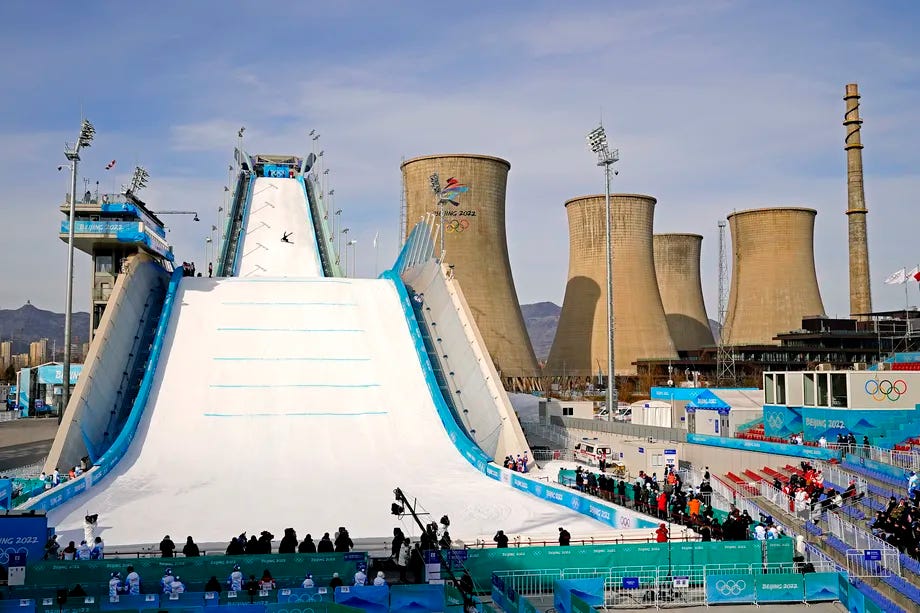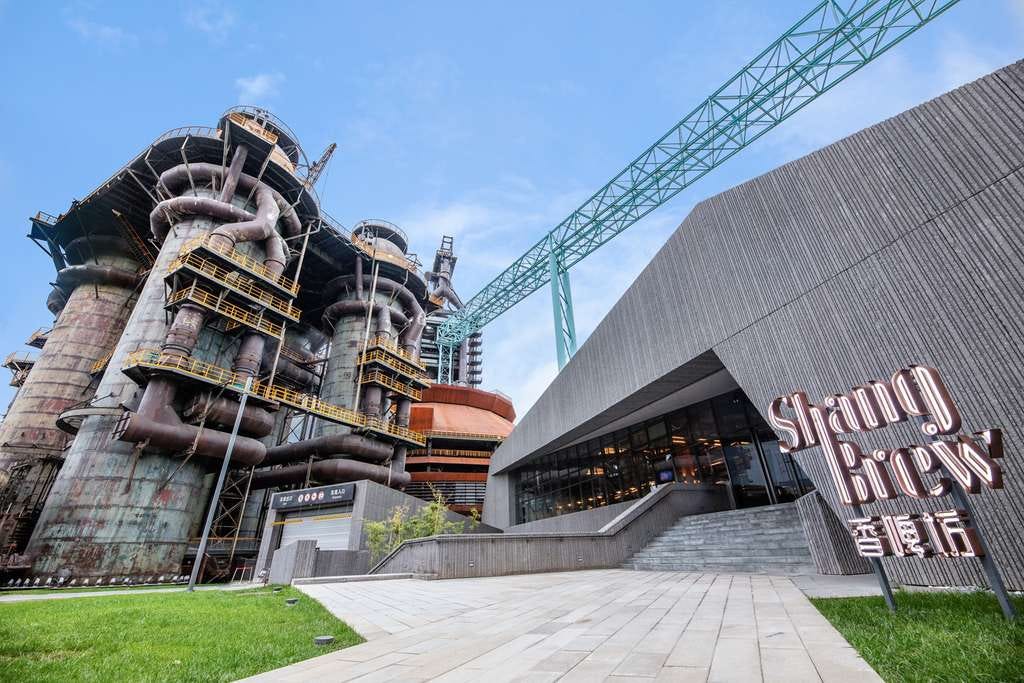16. Big Air Pollution Olympics
I think one of the more striking, and perhaps disturbing, scenes from the Olympics is not the brown-ish, snow-free mountains that surround the blinding ribbons of white at the Beijing National Ski Centre.
It’s those dystopian cooling towers that cast a shadow on the freestyle slopes at the Big Air Shougang center.
For almost 100 years, this location was home to an active steel mill, where raw ingredients like iron ore were smelted into steel. Steel production is an incredibly energy intense process because it requires very high temperatures; as a result, these factories, historically, have burned a lot of coal.
And with that, tons and tons of greenhouse gases and particulate matter are released into the atmosphere.
Fixing Air Quality
Prior to the 2008 Summer Olympics (also in Beijing), China recognized that their air quality would look poorly to the media, impact elite athletes’ performance, and provide fodder for visiting governments. Thick smog was a common occurrence and was viewed as a public relations threat to the 2008 hosts. Among a number of strategies to improve air quality, the Shougang steel mill was closed in 2005 in order to reduce greenhouse gas and particle emissions in Beijing.
It was moved, and reopened, on a small island in rural Hebei province, about 200km to the southeast. Problem averted? Nope, just moved to where the cameras won’t see it so it can continue emitting tons of air pollutants each year.
That’s not to say this is some sketchy thing done in dead of night to improve public relations during a internationally televised event. The United States took comparable measures in the 1984 Olympics in Los Angeles - at the time, one of the most polluted cities on earth. Cars were restricted and a ‘temporary’ bus transit system was launched. Almost 40 years later, that temporary transit system still moves people around today.
I’ll concede that I suspect these initiatives to improve conditions in 1984 had little to do with air quality, and more to do with reducing Los Angeles’ legendary traffic jams. In Beijing, the need was explicitly for better air quality. But since then, both places have seen marked improvements in air quality, whether it was intended or not.
Climate
Commentators are quick to explain that the Beijing region, while cold, is usually devoid of snow and therefore organizers have to rely on man-made snow. This explains why the downhill slopes are surrounded by barren earth - Beijing is on the margins of the Gobi desert, just a few hundred kilometers from the city, where there is relatively little wintertime precipitation. This is driven mainly by the annual East Asian monsoons, where cold, dry air arrives in winter, and warm, wet air replaces it in the summer.
While climate change certainly plays at least some marginal role to promote conditions where brown, arid land starkly contrasts bright white slalom runs, the main cause is because the Olympics are being held, partially, in a very arid environment.
That doesn’t mean that climate change isn’t important to the Olympics as a whole. A recent study shows us that 9 of the last 21 Olympics locations may no longer be suitable to host winter games in the future because of changing climate.
However, I’m not sure that’s the most important story. We cannot forget that Olympic athletes come from all over the world, where climate changes are having wide and varied impacts. This threatens where and when they can practice, how they can recruit new athletes to a sport, and increases potential dangers to athletes when they train and compete.
The irony is not lost on me that moving a steel plant from a gritty industrial zone to accommodate a ski jump facility may have freed up some space to host these games, but doing so just moved the real problem elsewhere.
Olympic Legacies
After the medals have been awarded and the crowds go home, China will be left a range of interesting infrastructure that can be repurposed. Life will go on with ski jumping at Shougang, slalom racing at the National Ski Centre, and curling at the National Aquatics Center. Okay, I’m not sure about that last one. Interesting side note: curling occurs on top of the Olympic pool in the infamous ‘Bird’s Nest’ where Michael Phelps became a national phenomenon in 2008.
In fact Shougang, in all its dystopian glory, has become a revitalized tourist attraction that does not require death-defiance from a 168-foot vertical drop jump. It is filled with modern cafes and shopping and even a brewery.
But between the Olympic glory and heartbreak, it’s important that we do not forget that our choices play an important role in our fates and futures. What we choose now is important for tomorrow and next year and next decade. Those ghostly images at Shougang make me think about how important these choices can be.
I’m grateful that local air quality has improved, and interesting urban development can take place. But I’m reminded again and again that we’ve only solved half of the problem. For now, that steel mill goes unseen on camera, but we all see its impacts as our climate changes across the globe.
Next time I’m in Beijing, you probably won’t see me doing any gold medal winning left double 1620s with a safety grab at Shougang.
Instead, I will do a safer trick. I’ll be having a pint.






